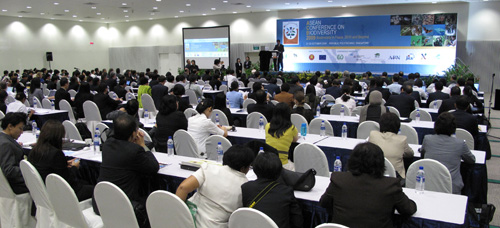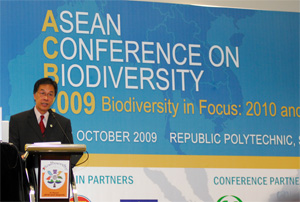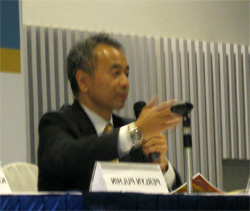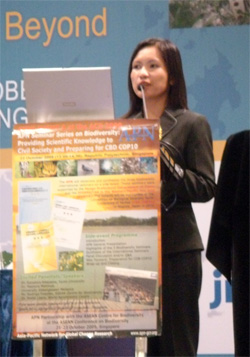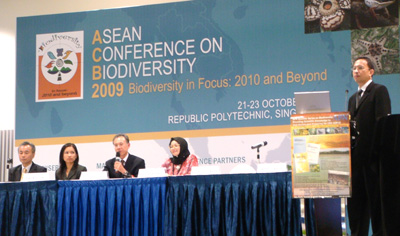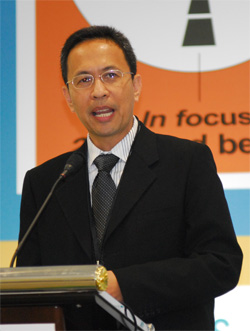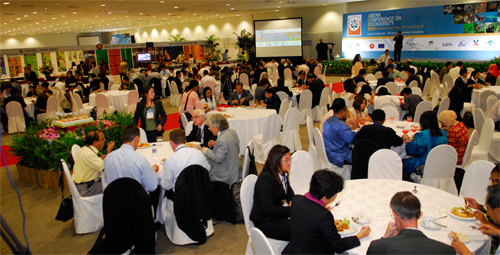 Very strong APN representation at the recently concluded Association of Southeast Asian Nations (ASEAN) Conference on Biodiversity that convened in Singapore on 21-23 October 2009 further raises APN profile as well as the relevance of its work not only in Southeast Asia (SEA) but in the whole Asia-Pacific region. The APN is one of the conference key partners and it managed to organise a side-event and an exhibit in this occasion. More information about the conference and APN’s active role are detailed below.
Very strong APN representation at the recently concluded Association of Southeast Asian Nations (ASEAN) Conference on Biodiversity that convened in Singapore on 21-23 October 2009 further raises APN profile as well as the relevance of its work not only in Southeast Asia (SEA) but in the whole Asia-Pacific region. The APN is one of the conference key partners and it managed to organise a side-event and an exhibit in this occasion. More information about the conference and APN’s active role are detailed below.
Landmark Event . Hosted by the ASEAN Centre for Biodiversity (ACB) and the National Parks Board (NParks) of Singapore, ACB2009 was held on 21–23 October 2009 at the Republic Polytechnic in Singapore, back-to-back with the ASEAN Ministerial Meeting on the Environment. This conference is one of this year’s most important gatherings of the best minds in the biodiversity arena. As one of the Conference Key Partners, APN was pleased that over 250 key stakeholders in the ASEAN region as well as experts, policy-and decision-makers in other parts of the world gathered for this Conference and discussed emerging trends, issues, and concerns on biodiversity conservation and sustainable management.
ACB2009 provided a platform to report and discus how ASEAN countries are faring against the 2010 Biodiversity Target of significantly reducing biodiversity loss. The conference also tackled important biodiversity issues in the region and a mong these outstanding issues and challenges include: 1) climate change and its impact on biodiversity; 2) the need to negotiate an international regime to promote and safeguard the fair and equitable sharing of benefits arising from the use of genetic resources; and 3) the valuation of the goods provided by nature. The next steps to be taken in order to advance the ASEAN biodiversity agenda with the context of meeting the 2010 Global Biodiversity Challenge and beyond 2010 were also discussed.
The three-day conference composed of plenary session for keynote addresses and key conference papers, exhibit/poster sessions, three parallel sessions, side-events (including the side-event organised by APN), launch of the ASEAN Heritage Parks Coffee Table Book, introduction to the enhanced ASEAN biodiversity database/information sharing service, launch of the ASEAN Champions of Biodiversity, and award ceremony for “Zooming in on Biodiversity”. These were the ACB2009’s main themes: Climate Change and Biodiversity, Access to Genetic Resources and the Fair and Equitable Sharing of Benefits Arising out of their Utilization (ABS), and Economics of Ecosystems and Biodiversity – the ASEAN Region’s Contribution. From these themes, a number of possible researchable areas on biodiversity conservation in the region and other capacity-building activities for the ASEAN Member States were identified. These will be assessed for further consideration of the ASEAN Centre for Biodiversity.
Policy recommendations were also formulated during the conference. These recommendations were formally presented to the ASEAN senior officials during the ASEAN Ministerial Conference that immediately followed the ACB2009, for their consideration and appropriate action. The Centre will finalise the ASEAN 2010 Biodiversity Report, using materials derived from the conference. Together, the Centre and the ASEAN Member States will launch this Report at the 10 th Conference of the Parties to the Convention on Biological Diversity (COP10/CBD) in Nagoya, Japan, in October 2010.
The participants were challenged to look more closely on the issues related to biodiversity conservation such as current status of the international regime on ABS; the roles played by the scientific community and policy-makers in decision-making; the need to develop taxonomists to take account of biodiversity species; and the significance of communication, education and public awareness activities to change attitudes and lifestyles in relation to the environment.
At the parallel session on Climate Change and Biodiversity, the following key issues were raised: availability of information on the impact of climate change in Southeast Asia; interest in the use of the vulnerability mapping for the region and possible inclusion of migration of people and land use planning layers into the formulation of the maps; impact of coral bleaching as a result of global warming; possibility of raising the status of the Coral Triangle Initiative to give it more significance, such as a Marine Heritage Area; human population pressure on mangroves; the significance of the possible 2-3 °C increase in sea temperature and the adaptation of coral reefs to cope with change and possible coral migration as a form of adaptation; adoption of a strategy similar to Reducing Emissions from Deforestation and Degradation (REDD) for the marine ecosystem to cope with marine loss; and the lack of discussion on the impact of climate change on alien species.
Parallel session 2 on Access to Genetic Resources and Equitable Sharing of Benefits Arising out of their Utilisation (ABS) raised the following significant points: difficulty in identification of country of origin and country providers; traditional knowledge (TK) vs. intellectual property rights as well as means on how to protect TK; recording and management of TK; protecting TK when it is not in written form; showcasing a model application of ABS; and the scenario of not having an international regime if negotiations do not succeed.
The salient points and key messages that were raised at the parallel session 3 on Economics of Ecosystems and Biodiversity include: developing countries such as those in Southeast Asia have a great role to play in the biodiversity conservation equation and they should be in control of the use of their resources to ensure that there is environment justice; researchers should be able to link science with policies so collaboration should be encouraged among policy-makers and scientists; micro and macro conservation activities should be linked; there should be better communication within the region so that biodiversity is better conserved – needs for innovative and tangible conservation programmes; farmers are important stakeholders in managing ecosystems and capacity-building initiatives should be provided; and there should be targeted policy for Payment for Ecosystem Services (PES).
Finally, it was stressed that the goal of sustainable development cannot be achieved by the government, non-governmental organisations (NGOs) and businesses alone. There is a need for collaborative efforts to convince the civil society to act responsibly and learn to live in harmony with nature. It must be difficult to change people’s behaviour towards biodiversity but unless specific actions are taken to address this, millions of people, especially the poor who heavily rely on natural resources to survive, will suffer. The major challenges such as the excessive consuming of rich people, the destructive methods of the poor sector, and the unsustainable ways of the corporations who are interested only in short-term gains, should be faced.
Side-event Overview and APN Introduction . As part of the Partnership Agreement signed between APN and ACB, APN was entitled to a side-event on the occasion of the ACB2009. The side-event “APN Seminar Series on Biodiversity: Providing Scientific Knowledge to Civil Society and Preparing for CBD COP10” was successfully held on 22 October 2009 at the Republic Polytechnic, Singapore. This APN side-event which convened in parallel with other two side-events attracted around 60 participants. Four experts on biodiversity field were invited as speakers and panellists.
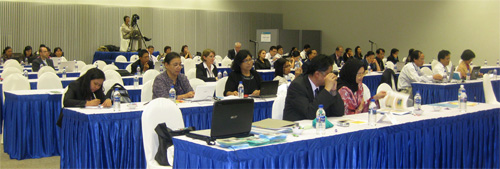 The main objective of the side-event was to showcase and synthesise the last three international seminars that APN organised. Biodiversity was the central theme of these last three seminars that aimed at raising the awareness of civil society on the importance of biodiversity for the Asia-Pacific region particularly in relation to human intervention and sustainable development. APN Secretariat Director, Mr. Tetsuro Fujitsuka, the Chairperson of the side-event, briefly introduced the following international seminars that are biodiversity-related:
The main objective of the side-event was to showcase and synthesise the last three international seminars that APN organised. Biodiversity was the central theme of these last three seminars that aimed at raising the awareness of civil society on the importance of biodiversity for the Asia-Pacific region particularly in relation to human intervention and sustainable development. APN Secretariat Director, Mr. Tetsuro Fujitsuka, the Chairperson of the side-event, briefly introduced the following international seminars that are biodiversity-related:
- International Seminar on “Pathways Towards a Sustainable Society with Biodiversity Conservation” (February 2007)
- International Seminar on “Global Warming and Ecosystem/ Biodiversity Changes: Facing the Challenge of Changing Ecosystems” (December 2007)
- International Seminar on “ Biodiversity and Human Dimensions: Promoting Harmonious Coexistence” (February 2009)
|
The APN Secretariat Director also noted the other three objectives of the side-event: 1) to exchange perspectives on initiatives that address biodiversity issues in the region; 2) to identify potential collaborative activities and specific steps toward achieving the 2010 Biodiversity Target and beyond; and 3) to provide input at the CBD COP10 in Nagoya, Japan in 2010. He encouraged everyone to actively participate in the open discussion and invited them to visit the APN exhibition booth for detailed information about the topics that were covered and the speakers who were invited in the three seminars.
|
Following the side-event overview explained by Mr. Fujitsuka, the APN Programme Officer for Communications and Development, Ms. Perlyn Pulhin gave a brief general presentation about APN and its major activities in the Asia-Pacific region.
Highlights/Synthesis of the Three Biodiversity International Seminars . Dr. Kanehiro Kitayama, Kyoto University, Japan and Dr. Mastura Mahmud, University Kebangasaan Malaysia presented the highlights of the seminars that were conducted while Mr. Rodrigo Fuentes, ACB Executive Director, provided the synthesis of the three seminars.
To achieve a harmonious co-existence between nature and people, Dr. Kitayama noted the importance of knowing the ecosystem services that are provided by biodiversity. He cited some examples wherein biodiversity is sustained in a society where human interact directly but in harmony with nature. However, concern was raised on the rapidly changing ecosystems and biodiversity due to socio-economic development and land-use as well as climate change. He explained further how these two factors are affecting ecosystems and biodiversity.
There were success stories highlighted in the seminars that APN organised where economic incentives are bringing about win-win consequence. Dr. Kitayama shared these stories to the participants but pointed out that economic incentives may not work without awareness, knowledge and institutions. It is therefore crucial to sustain the researches on biodiversity, continue educating the civil society and provide policy-makers with the appropriate and timely information toward a sound decision-making.
In discussing the pathways towards a sustainable society with biodiversity conservation, Dr. Mahmud noted that the rich biodiversity of ecosystems provides for the well being of the human society. Unfortunately, diverse changes in biodiversity threaten human societies by reducing the ecosystem’s ability to provide a series of benefits. To maintain and protect the ability of the biodiversity and the different ecosystems in providing services and to achieve the success of a sustained biodiversity, Dr. Mahmud stressed that there is a need to include sociological and economical aspects in the international discussions. The urgency for a systematic compilation, accumulation, circulation and utilisation of properly gathered information for biodiversity was also stressed.
Another notable point that Dr. Mahmud raised was that biodiversity and ecosystems will definitely undergo changes and that global warming will proceed to an extent that poses negative effects on these two elements. Therefore, action must be taken in order to adapt to climate change and global warming.
Mr. Fuentes presented the main challenges identified in the seminars and how these challenges could be addressed as discussed in the parallel discussion of each of the three seminars that APN conducted. In facing the threat of losing and altering biodiversity due to rapid economic development and land-use changes, he noted that it is important to promote awareness on the benefits being obtained from biodiversity and the cost associated with its loss. There is a need also to integrate/harmonise efforts of social and natural scientists, policy-makers and the general public on biodiversity conservation then put policy into action and practices to achieve a sustainable society.
The negative impacts of climate change and global warming on biodiversity and ecosystems was stressed as another major challenge. Mr. Fuentes emphasised the need to adapt to climate change and global warming and to avert the negative effects on biodiversity and ecosystems. It is crucial that experts/scientists exert more effort to effectively communicate the scientific knowledge and research results to policy-makers and the civil society so they will be prepared and act the best way forward.
With respect to the challenge on the poor recognition of how individual human activities negatively affect biodiversity, Mr. Fuentes said that it is necessary to review and evaluate local values which are culturally unique to the region and also understand the connections and relationships amongst all living creatures and how these relate to human day-to-day activities. It was captured in the seminar organised by APN that the vital role of ecosystem regulation services should be incorporated in economic activities and since there are so many issues that are related to biodiversity, this should be considered from a more comprehensive viewpoint instead of focusing on a single aspect only.
It was highlighted in the panel discussion that strategies to stabilise the ecosystems, conserve biodiversity and mitigate the effects of global climate change must be pursued through international cooperation. Collaborative activities/projects at the local level should be emphasised and duplicated especially those that were proven effective and efficient for conserving biodiversity which is under the pressure of human activities. At the wrap-up and closing session, it was stressed that to support developing countries in implementing adaptation measures and protecting the biodiversity/ecosystems, international networks such as the APN play important role in facilitating the transfer of scientific knowledge and technologies into policies, action and practices.
Exhibition . An exhibit space was provided to APN for the duration of the Conference where APN materials/ publications such as brochure, poster, CD-ROM, Annual Report, Project Bulletin, book, proceedings, flyer, etc. were showcased for display and dissemination. APN also displayed and distributed materials of partner organisations such as the 3 rd Hyogo Fundamental Plan for the Environment and Hyogo Biodiversity Strategy and some DIVERSITAS publications.
APN Visibility. APN was acknowledged by ACB at the Opening and Closing Ceremony of the conference. APN’s logo was also displayed on the banner, conference website (with link), backdrop and all the conference materials/documents and information kit that were distributed to the participants including the conference programme and booklet, name tag, certificate of participation, etc. In the conference booklet, the APN side-event was properly cited and APN profile was also featured under the Conference Partners’ page. Every opportunity to network with the representatives of various organisations , especially through the exhibition and coffee/tea or lunch breaks, were used in order to establish new links, strengthen current partnership and raise visibility of APN’s activities not only in the ASEAN nations but in the whole Asia-Pacific region.
